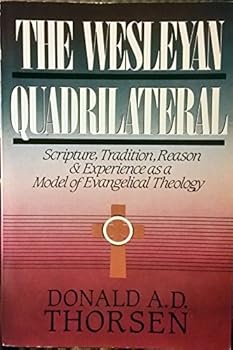The Wesleyan Quadrilateral: Scripture, Tradition, Reason & Experience as a Model of Evangelical Theology
Select Format
Select Condition 
Book Overview
In this important study Thorsen assesses John Wesley's use of sources for theology. Although Scripture was his highest source, Thorsen shows how Wesley made use of other sources as well. This description may be from another edition of this product.
Format:Paperback
Language:English
ISBN:0310753414
ISBN13:9780310753414
Release Date:January 1990
Publisher:Zondervan Publishing Company
Length:333 Pages
Weight:0.84 lbs.
Customer Reviews
1 rating
Wesleyan Quadrilateral
Published by Thriftbooks.com User , 15 years ago
Those interested in the roots of the Wesleyan way will profit from perusing Donald A.D. Thorsen's The Wesleyan Quadrilateral: Scripture, Tradition, Reason and Experience as a Model of Evangelical theology (Grand Rapids: Zondervan, c. 1990). Thorsen taught at Azusa Pacific University, and this treatise reflects his thoroughly academic concerns--extensive footnotes, at times technical theological discussions, extensive quotations. Yet the use of the "Quadrilateral" enables him to bring coherence and system to Wesley's thought, and I find the book quite worthwhile. In Thorsen's opinion, "Perhaps Wesley's most enduring contribution to theological method stems from his concern for catholicity in including experience along with Scripture, tradition, and reason as genuine sources of religious authority" (p. 125). Now Wesley himself never proposed any tidy, teacher-friendly "quadrilateral" as a paradigm for Wesleyanism. Albert Outler, in the 1960's, first proposed the notion, so it is "a modern attempt to summarize the fourfold set of guidelines Wesley used in reflecting on theology" (p.21). As Thorsen insists, so long as it is understood as a helpful "heuristic tool," not a rigid corral within which to contain wily mustangs, the quadrilateral enables Wesleyans to better conceptualize their theology. If one wanted a more accurate "geometric figure as a paradigm for Wesley," he says, "a tetrahedron--a tetrahedral pyramid--would be more appropriate" (p.71). But please, Dr. Thomsen, the "quadrilateral" is awkward enough! So let's have no talk about tetrahedrons! As a practitioner of the Anglican via media tack¬ing gracefully between the winds of Protestant¬ism and the currents of Roman Catholicism, John Wesley naturally sought to study and utilize, to recognize and reconcile, diverse truth-tests. He probably followed his father's advice, published as Advice to a Young Clergyman, and studied "logic, history, law, pharmacy, natural and experimental philosophy, chronology, geography, the mathematics, even poetry, music or any other parts of learning" (p.50). Thus he favorably cited, in various con¬texts, the worth of Scripture, Tradition, Reason and Experience. Of the four, of course, Wesley primarily relied upon Scripture. In a letter written early in his ministry, Wesley said: "I allow no other rule, whether of faith or practice, than the Holy Scriptures" (p.127). He often claimed to be a "man of one book" and affirmed the Reformation principle of sola Scriptura. Yet he took solus to mean "pri¬marily" rather than "exclusively." Other sources of truth, so long as they complement and stay sub¬ordinated to Scripture, add to man's grasp of God's Truth. Tradition, especially that of "Christian antiquity," formed Wesley's second source of authority. The Fathers of the Church, the Ecumenical Creeds, the Anglican Books of Homilies, all enabled one to more wisely interpret God's written Word. Though innovative in many ways, We






